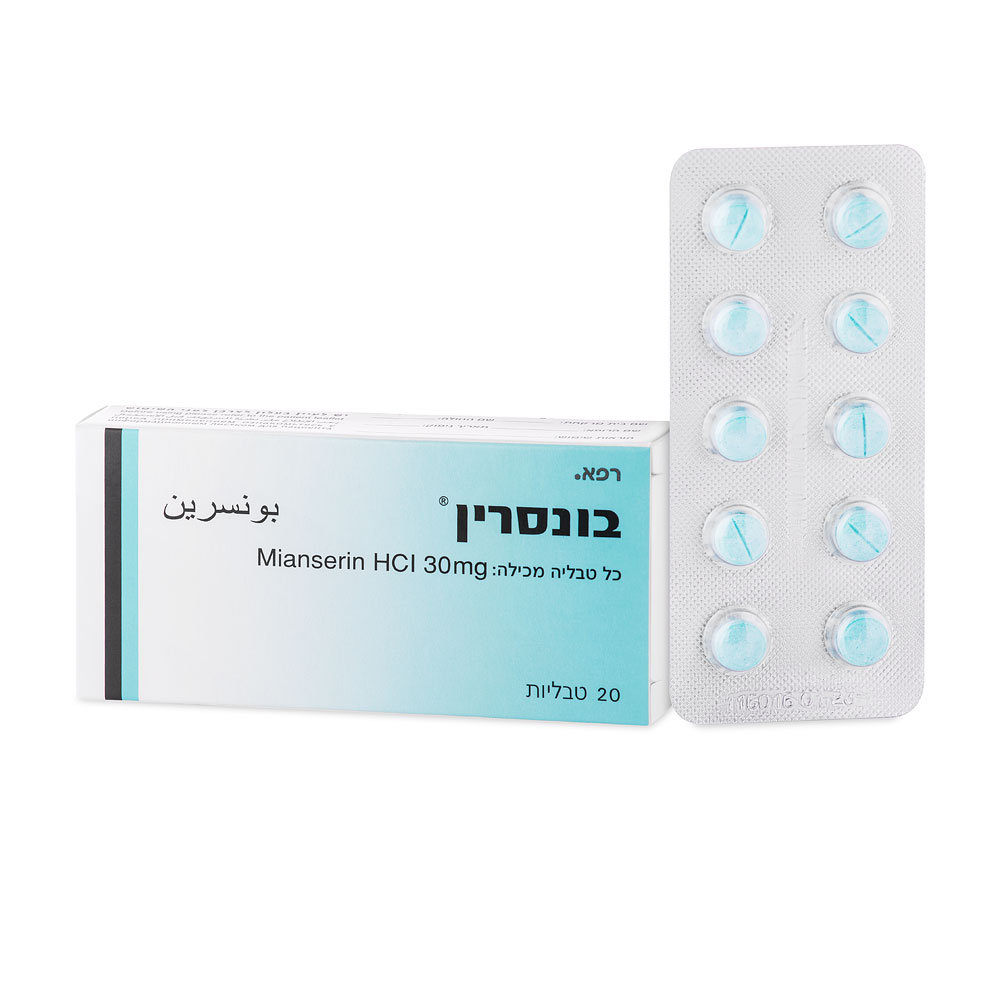Quest for the right Drug

בונסרין BONSERIN (MIANSERIN HYDROCHLORIDE)
תרופה במרשם
תרופה בסל
נרקוטיקה
ציטוטוקסיקה
צורת מתן:
פומי : PER OS
צורת מינון:
טבליה : TABLETS
עלון לרופא
מינוניםPosology התוויות
Indications תופעות לוואי
Adverse reactions התוויות נגד
Contraindications אינטראקציות
Interactions מינון יתר
Overdose הריון/הנקה
Pregnancy & Lactation אוכלוסיות מיוחדות
Special populations תכונות פרמקולוגיות
Pharmacological properties מידע רוקחי
Pharmaceutical particulars אזהרת שימוש
Special Warning עלון לרופא
Physicians Leaflet
Overdose : מינון יתר
4.9 Overdose Symptoms Symptoms of overdosage may include nausea and vomiting; dry mouth; constricted or dilated pupils; nystagmus; dizziness; ataxia; slow tendon reflexes; drowsiness; convulsions and coma. Cardiovascular effects reported include tachycardia or bradycardia; hypotension or hypertension; ECG abnormalities including ST elevation; PR interval shortening; first degree to complete heart block. In severe cases ventricular fibrillation and cardiac arrest may develop. Features of serotonin toxicity may occur. These include CNS effects (including agitation or coma); autonomic instability (including hyperpyrexia); and neuromuscular excitability (including clonus and raised serum creatine kinase). This syndrome is more likely to occur if the patient has been exposed to two or more drugs that increase the effect of serotonin in serotonergic synapses (by increasing release, reducing reuptake or metabolism, or stimulating serotonin receptors), either as ϲ an acute overdose or if taken regularly, for example - SSRIs, MAOIs, tricyclic antidepressants, venlafaxine, tramadol, triptans, linezolid and St John's Wort, stimulant drugs of abuse (e.g. MDMA (ecstasy), amphetamines, cocaine, cathinone derivatives (mephedrone, etc.). The cardiovascular and CNS effects in overdose will be potentiated by simultaneous ingestion of alcohol, cardiovascular agents and other psychotropic drugs. Treatment There is no specific antidote. Do not give flumazenil to reverse benzodiazepine toxicity in mixed overdoses. The benefit of gastric decontamination is uncertain. Consider activated charcoal (charcoal dose: 50 g for adults; 1 g/kg for children) if the patient presents within 1 hour of ingestion of more than 5 mg/kg of bodyweight. The patient should be observed for at least 6 hours after ingestion. Symptomatic patients should be observed for a minimum of 24 hours, due to the potential for delayed cardiac effects. U&Es and glucose levels should be checked. A 12 lead ECG should be performed, and BP, pulse and cardiac rhythm should be monitored. Perform an arterial blood gases test in patients showing ECG abnormalities. Correct hypotension by raising the foot of the bed and by giving an appropriate fluid challenge. Bradyarrhythmias and tachyarrhythmias should be treated appropriately. If severe hypotension persists despite the above measures, then central venous pressure monitoring should be considered. Manage in a critical care area or involve the critical care outreach team. When hypotension is mainly due to decreased systemic vascular resistance, drugs with alpha- adrenergic activity such as noradrenaline or high dose dopamine (10-30 micrograms/kg/min) may be beneficial. The dose of vasopressor should be titrated against blood pressure. When hypotension is believed to be due to reduced cardiac output (e.g. where global hypokinesia is demonstrated on echocardiography) inotropic drugs such as dobutamine, or in severe cases adrenaline, may be beneficial. NB. Both negative inotropic and vasodilator actions may both be present, particularly in mixed overdoses. If severe hypotension further persists, discuss with your local poisons information service. For symptomatic bradycardia give atropine intravenously, 0.5-1.2 mg for an adult or 0.02 mg/kg for a child. Repeat doses may be necessary. Dobutamine or isoprenaline may be considered if bradycardia is associated with hypotension. Temporary pacemaker insertion may be required; alternatively external pacing may be used. Single brief convulsions do not require treatment. Give oxygen, check blood glucose, U&Es and ABG. Correct acid base and metabolic disturbances as required. ϳ If convulsions are frequent or prolonged, control with intravenous diazepam (10-20 mg in adults; 0.1-0.3 mg/kg body weight in children) or lorazepam (4 mg in an adult and 0.1 mg/kg in a child). If unresponsive to the above measures, consider phenobarbital sodium (10 mg/kg at maximum rate of 100 mg/minute; maximum dose 1 g). An alternative is phenytoin (loading dose 18 mg/kg IV infusion in adults and children, given via slow IV infusion [maximum rate 50 mg/minute] over 20-30 minutes with BP and ECG monitoring). However, the use of phenytoin may worsen cardio toxicity in the presence of sodium channel blocking agents. If convulsions persist, consider the need for referral to intensive care, general anaesthesia, intubation and ventilation. There may continue to be epileptiform activity and measures to monitor and control this are necessary. Use of cerebral monitoring is therefore recommended. Thiopental is the preferred antiepileptic for status epilepticus not responding to the above measures. The role of newer agents such as propofol and levetiracetam in toxicological seizures is currently unclear because of a lack of clinical or animal studies. Other measures should be taken as indicated by the patient's clinical condition. Paediatric population Children failing to respond to an appropriate intravenous fluid bolus require early discussion with the local paediatric intensive care unit (PICU).

שימוש לפי פנקס קופ''ח כללית 1994
Antidepressant
תאריך הכללה מקורי בסל
01/01/1995
הגבלות
תרופה מוגבלת לרישום ע'י רופא מומחה או הגבלה אחרת
מידע נוסף
עלון מידע לצרכן
25.01.16 - עלון לצרכן אנגלית 25.01.16 - עלון לצרכן עברית 25.01.16 - עלון לצרכן ערבית 25.08.23 - עלון לצרכן עברית 08.02.24 - עלון לצרכן אנגלית 08.02.24 - עלון לצרכן עברית 08.02.24 - עלון לצרכן ערבית 08.08.24 - עלון לצרכן עברית 30.03.15 - החמרה לעלון 06.09.23 - החמרה לעלון 08.08.24 - החמרה לעלוןלתרופה במאגר משרד הבריאות
בונסרין